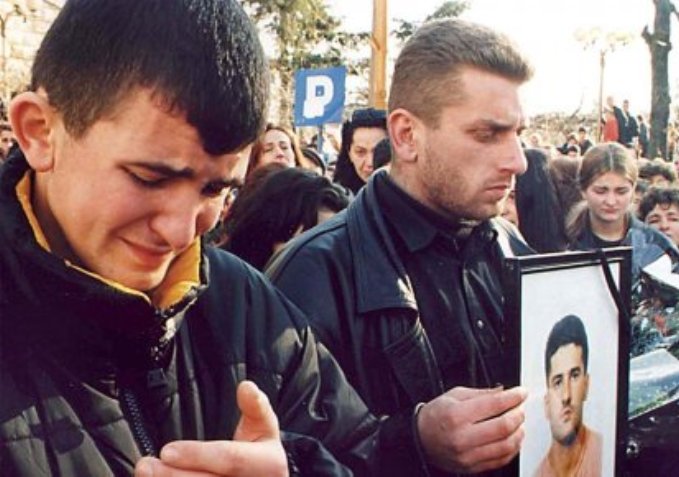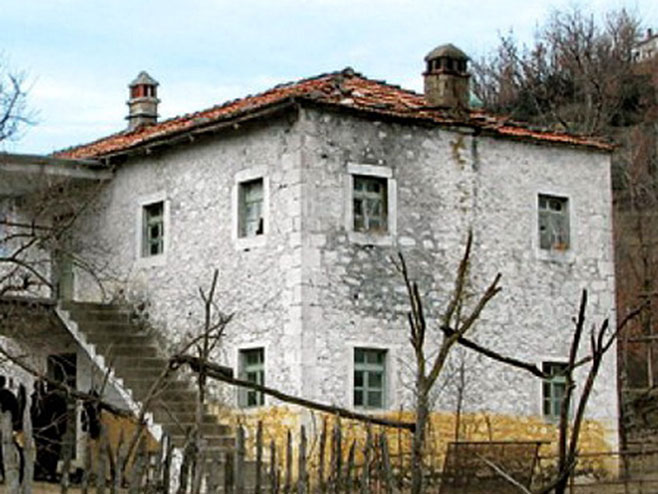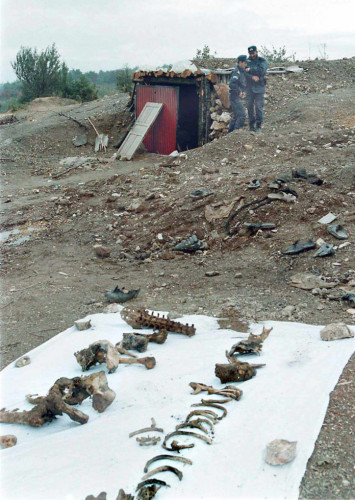Period:
Yugoslav Wars
Region:
Kosovo and Metohia
The Albanian camp Likovac in Kosovo 1998-1999
The Likovac camp was an Albanian concentration camp under the control of the Kosovo Occupation Army in the late 1990s in the vicinity of Srbica in the central parts of Kosovo and Metohija.
Mostly Serbs, non-Albanians, and members of the Albanian national community, who were loyal to the state institutions of the Republic of Serbia, i.e. FR Yugoslavia were brought to it.
The Likovac camp is just a link in the genocidal series of camps made by the Albanian separatists in Kosovo and Metohija with the goal of ethnic cleansing and extermination of Serbs from their centuries-old hearths.
The exact number of detainees will hardly ever be known, but it is assumed that there were 400 to 500 of them from 1998 to 2000. The Likovac camp was under the jurisdiction of the Drenica group of the so-called KLA (Kosovo Occupation Army), and Fatmir Ljimaj was the camp commander.
All the highest representatives of the Albanian parallel civilian and paramilitary structures in Kosovo and Metohija knew about this death casemate, but they did nothing to close the camp, but it was done only a year after the arrival of KFOR and UNMIK in the Kosovo and Metohija area.
In addition to this camp, there were camps in: Lapušnik, Glođan, Klečka, Ovčarevo, Trpeza, and Zočište… According to the Association of Kosmet Victims, there were at least 144 camps in the territory of Kosovo and Metohija in the period 1997-2000, with imprisoned Serbs, Roma, and (dis)loyal Albanians.
The Hague Tribunal refused to prosecute all those responsible although the War Crimes Prosecutor’s Office in Belgrade submitted comprehensive documentation.
BACKGROUND
The Federal Republic of Yugoslavia (1992-2003) was the third Yugoslavian state formed as a result of the disintegration of the Federal State of Yugoslavia, when Serbian and Montenegrian delegates proclaimed the constitution in Žabljak in April 1992.
At the same time, in the territory of the Federal State of Croatia, Croatian forces continued with their aggression against Krajina Serbs, who had formed their Republic of Serbian Krajina.
In Bosnia and Herzegovina, a bloody war was already in progress between Serbs, Muslims, and Croats. These conflicts ended in the Autumn of 1995 when the Dayton Peace Agreement was signed in the state of Ohio.
Soon, American military campaign became centered around assisting Albanian separatists from Kosovo and Metohija, providing them with weapons and logistics, and creating terrorist camps in Albania. This is when the Albanian terrorist group (KLA) was formed, whose members were illegally transported into the territory of Yugoslavia aimed at looting, trafficking, destabilization, and provocation of conflicts with the Police and Army of Yugoslavia.

Funeral of Serbian victims in Peć- December 1998.
In the Spring of 1998, conflicts between Albanian terrorists and members of Yugoslavian police intensified, resulting in the war, with a lot of casualties on both sides. Albanian terrorists were directly supported by the Western countries.
This support also included threats by the NATO that it would intervene in the conflict if Belgrade kept refusing to decrease the number of soldiers and policemen in Kosovo and Metohija.
In the Autumn of 1998, NATO began to bring its soldiers and technique to the Vardar Macedonia and Albania, while the “Milošević-Hoolbruk” agreement helped to prevent aggression against Serbia on 13 October 1998.
ESTABLISHMENT OF THE CAMP
Likovac is a small village in the central parts of Kosovo and Metohija, i.e. on the road between Priština (46 km) and Peć (48 km). Territorially, it belongs to the municipality of Srbica, 17 km to the southwest.
In this very village was a stronghold of the Drenica group (one of the seven zones) of the Occupation Army of Kosovo (KLA) who committed horrible crimes against Serbs on the territory of Metohija.
This camp was established in mid-April 1998 and was located in a former police station building. The commanders in this camp were Fatmir Limaj and Sulejman Selimi.
The Military Police of the Occupation Army of Kosovo (KLA) had direct jurisdiction over this camp, where the commander-in-chief was Sahiti Jashari, a close relative of Adem Jashari, who was killed on 7 March 1998 in an action by special forces of the Ministry of Interior Affairs of Serbia.
At the end of June 1998, in the village Belacevac in the wider vicinity of the city of Priština, a group of Albanian terrorists (KLA) kidnapped a dozen miners who were employed at the Thermal Power Plant Obilić. More precisely, their bus was intercepted and all of them were kidnapped and taken away in an unknown direction.
It was later learned that they were taken to the Likovac camp. In fact, the Albanian mill for Serbs continued then. In the following days, Albanian terrorists brought even more Serbs from various parts of Kosmet.
CAMP OPERATION
The Likovac camp was operating uninterruptedly for more than two years.
Similar to other camps on the territory of former Yugoslavia during the 1990s. The victims. who were killed were buried in mass graves, while a good part of the victims was transferred to the Republic of Albania, the town of Burrell. Their organs were harvested there and sold on the black market across Europe.

"Yellow house" - horror movie a live
In the Likovac camp itself, all the prisoners, no matter their sex, age, or medical condition were exposed to horrible psychological and physical torture.
Guards in the Likovac camp were members of the 111th, 112th, 113th, and 140th brigades of the Kosovo Occupation Army. The deputy commander of the camp in Likovac was Sabit Geci.
During 1998-1999, about 80 Serbs from the municipality of Djakovica alone were kidnapped and taken to the Likovac camp.

The Likovac camp was considered one of the five most notorious of 144 Albanian casemates that existed in the area of the Autonomous Province of Kosovo and Metohija at the end of the 1990s. Plus about twenty more camps were established in the northern parts of the Republic of Albania.
TESTIMONIES
Nataša Šćepanović, president of the Association of Kosmet Victims says the following about the Likovac and other camps in Kosovo and Metohija:
- “In all these places, Serbs went through hell and torture, these were cruel execution sites, it was most horrible in the Yellow House in the north of Albania, where kidnapped Serbs had their organs harvested...
They burned people alive, and many were torn to pieces by being tied to tractors; they were tortured in the most vicious ways.
Actually, none of the killed Serbs, Roma, and disloyal Albanians lost their lives without being tortured in ways incomprehensible to human reason...".
Simo Spasić, whose brother was kidnapped and ended in Albanian camps:
- “The prisoners were in the basements of private houses, barns, hangars, and empty primary schools. In 1998, there were mostly ‘mobile camps’ which were moved due to the fear of our security organs. They would move from one place to another, then to a third one, and most of the survivors would end up in northern Albania
Only in the Drenica area, there were multiple camps, like the one in Likovac under the command of one of the Occupation Army of Kosovo leaders and the Hague indictee Fatmir Limaj.

The organizer of Albanian camps: Hashim Thaci with his security
My brother, who was kidnapped on 14 May 1998 was also in that camp. Thanks to some Albanians, I was able to talk to him while he was detained with some other Serbs, and they were held in caves around Glogovac”.
NAMES OF THE TORTURERS
The names of the guards and their superiors that were remembered by the prisoners:
-
Sami Lushtaku,
-
Sait Jashari
-
Jahir Demaku
-
Zecir Demaku
-
Hisni Thaci
|
-
Suleiman Selimi
-
Fadil Demaku
-
Sabit Geci,
-
and others.
|
NAMES OF THE VICTIMS
-
Ljubomir Knežević, a journalist, kidnapped on 6 May 1999
-
Žarko Spasić, a worker of Electric power industry of Serbia who, worked at the Belaćevac mine, kidnapped on 14 May 1998
-
Dejan Stoiljković, a police officer from Gnjilan, kidnapped on 19 May 1998
-
Vladimir Spasić, kidnapped on 19 May 1998
-
Miroslav Šuljinić, a worker from Klina, kidnapped on 21 May 1998. His body was found in a mass grave near Lapušnik in 2005.
-
Ivan Bulatović, a police officer from Peć who was kidnapped from a train in Glogovac in late May. He was beheaded in the Likovac camp with a saw.
-
etc...
YEARS LATER
When the fighting in Kosovo and Metohija ended in June 1999 after the Military Technical Agreement had been signed in Kumanovo, the Yugoslav security organs withdrew: the Army, the Police, as well as state institutions. That caused the mass exodus of hundreds of thousands of Kosmet Serbs.
At the beginning of October 2000, there was a change in the political power in Serbia, when Zoran Đinđić, and later Vojislav Koštunica, formed the government. They made a radical turn in the foreign policy of our country, i.e. it was the policy of Euro-Atlantic integrations.

Under these conditions, more than 2,100 Albanian criminals were released from Serbian state prisons. They had been sentenced to many years in prison for serious criminal offenses: murders, tortures, rapes, robbery, etc. They did not ask the Albanian party to release Serb civilians from Albanian camps under their control.
The fate of more than 1,647 Serbs from Kosovo and Metohija is still unknown.
TRIALS AND JUDGMENTS
After the end of the aggression and the barbaric 78-day bombing of Serbia and Montenegro, UNMIK and KFOR forces, and later EULEX mission, came to the southern Serbian province.
At one of the trials of the Drenica group, where the commander-in-chief was Hashim Thaci, the international prosecutor Clint Williamson showed video footage from the Likovac camp, which clearly shows the faces of the imprisoned Serbs, including Žarko Spasić, a worker from the Belaćevac mine; Dejan Stoiljković, a police officer from Gnjilan, as well as several Serbs who were kidnapped in May 1998.
In 2011, the Priština court of the so-called Republic of Kosovo sentenced Sabit Geci to 15 years in prison for the murder and torture of prisoners in several camps: Kukeš and Cakan. However, this verdict refers to Albanian victims, not Serbs. Geci was also identified as one of the main suspects in the “Yellow House” case because he used to transfer prisoners from Kosmet to the central parts of Albania.
Dick Marty, a lawyer and senator from Switzerland, also prepared a report in 2010 stating details about Albanian concentration camps with mostly Serbs detained.
The War Crimes Prosecutor’s Office of the Republic of Serbia has information that the victims from the Likovac camp were buried on the territory of the municipality of Đakovica in the southern parts of Kosovo and Metohija, on the location of the village Piskota. In 2014, The EULEX Prosecutor’s Office investigated this information.

Albanian crmiinal: Ramush Haradinaj
Extensive documentation of about 3,000 pages was submitted to the Hague Tribunal with evidence on the existence of Albanian camps where Serbs were tortured and murdered in the late 1990s, but the Tribunal ignored the evidence. The reports, among other things, mention the name of a doctor Tima Kadrjaj, a former member of the so-called Kosovo Occupation Army, who was involved in the criminal operations related to the so-called Yellow House, i.e. transferring Serb prisoners there. Kadrijaj later became a member of Parliament of the so-called Republic of Kosovo from the Alliance for the Future of Kosovo, led by Ramush Haradinaj.
PUBLICATIONS
No documentary about the Likovac camp has been filmed so far, nor has any book been written that would testify about the horrors of the casemates that Serbs and non-Albanians went through.
There is only one video of the Association of Kosmet Victims where you can hear and see the authentic testimonies of the survivors.
Veselin P. Dželetović wrote the book “The Serbian heart of Johann” which is mostly about the Yellow House camp. The book has been reprinted several times and translated into many languages.
Tags:
Please, vote for this article:
Visited: 3916 point
Number of votes: 28
|